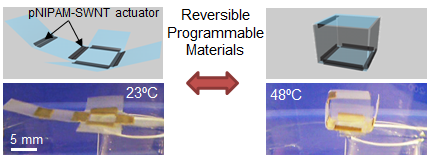Programmable
Materials
The
conversion
of external stimuli into mechanical motion capable of performing work
is at the
foundation of fields centered around the fabrication of microrobotics,
artificial muscles, and advanced smart actuator systems for diverse
applications. Stimuli-responsive
materials, such as shape memory
alloys,
dielectric polymers, electro-active polymers, and polymer hydrogels are
examples of material frameworks that appeal to these emerging
applications. Our
group is working on developing materials, structures and devices that
can reversibly
change their shape, color, and functionalities on command by
applying external stimuli. The applied stimulus could
include light, temperature or pH
change. As
an
example, we have shown that by properly patterning and engineering
hydrogels on
plastic substrates, self-folding cubes and “flowers” can be made that
reversibly respond to a small change of temperature (Nano Letters,11, 3239-3244, 2011).

More
recently, we have demonstrated motors
that can self-propel toward or
away from
incident light, and we have developed smart curtains that can
spontaneously
close or open upon light exposure (submitted, 2013).
Moving
forward, we envision developing
new
types of electronic systems, where not only stimuli can be
detected but
the system can also respond by changing its shape and/or physical
properties.
This presents a new class of user-interactive substrates.



